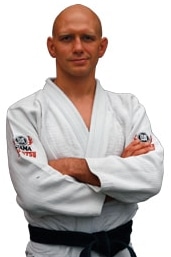
The purpose of this article is to answer any questions you might have about starting to train in Brazilian Jiu-Jitsu, and your first class in particular. Every school is different, but this article will help you understand how MOST Brazilian Jiu-jitsu schools operate.
You’ll find a glossary of basic Brazilian Jiu-Jitsu terms at the bottom of this article. This is to help you understand any technical words used here or in your first class.
Just Visiting?
At most schools you can watch a class, meet the teacher and ask some questions before ever getting on the mats.
What to Wear
Before you come to your first class, you’ll need to figure out what to wear.
You usually don’t need to own a Brazilian Jiu-Jitsu gi for your first class. T-shirts, board shorts and sweat pants are all fine. Sometimes you can wear a gi or uniform from another martial art (ask the instructor about this issue). You will need to buy a Brazilian Jiu-Jitsu gi if you continue training.
Do NOT wear anything with extra pockets, belt loops or baggy fabric. These are dangerous since fingers and toes can get caught in them. Baggy cargo shorts are a common example of what not to wear.
If you already own them, you can wear any protective gear (knee braces, ear guards, mouth guard, cup, etc.) you feel you need, with the exception of wrestling shoes (some clubs allow shoes, others don’t). Athletic tape can be used to protect injured fingers or toes.
Hygiene
Make sure your finger and toe nails are well-groomed. If you have long hair, you’ll want to put it up in a ponytail or bun during class. You should also remove any piercings to prevent injuries.
Your First Class
You’ll probably want to show up a couple minutes early to introduce yourself to the instructor and check out the school (if you haven’t visited already). You’ll often need to sign a waiver.
Before class starts, you’ll have a chance to get dressed and stretch out on the mats. Be sure to get everything ready before class starts so you don’t have to miss anything.
Warm-ups
Some teachers use a very light warmup, whereas others start the class with a heavy-duty conditioning session. Most classes start with a group warm-up, such as running laps and doing push-ups, followed by solo drills like forward and backward breakfalls and shrimping. Those last three moves will probably be new to you, so just watch what everyone else is doing and try to copy them. These are to help you learn how to fall safely and move your hips on the ground.
Don’t worry if you don’t get the exercises correct at first—no one does on their first day, and they take a little practise. Just give it your best try and the instructor or a higher belt will make sure you learn to do it right.
Techniques
After warm-ups, you’ll be partnered with someone and go to your own section of the mats to be taught your first lesson. At some schools you will practice a beginner curriculum, and at others you will simply do whatever techniques are being taught that day. An example of a beginner curriculum might be learning and drilling the following four techniques:
- Upa mount escape.
- Guard pass to side control.
- Taking mount from side control.
- Americana armlock(no-gi) or cross collar choke (with gi).
I think it will help you learn these techniques if you understand why they are taught.
Position Before Submission
One of the core principles of Brazilian Jiu-Jitsu is “position before submission”. By “position” is meant the relative position of your body to your opponent’s. By “submission” is meant an action that causes your opponent to submit (surrender), such as an armlock or choke.
It can be demonstrated that different positions in grappling offer varying degrees of control, and that those with the most control offer the best leverage for submissions and striking, with the least threat of counter-attack or escape. It is from this that Brazilian Jiu-Jitsu teaches you to seek and advance towards dominant positions and only attempt submissions once these are obtained. This also includes escaping from inferior positions to a neutral or dominant position.
You can see this principle contained in the four techniques we talked about earlier:
You start in a bad position (under mount) and escape to a relatively neutral position (in the guard), then advance (pass guard) to a dominant position (side control), and then take an even more dominant position (mount), at which point you have the control and leverage to effect a submission (americana or cross collar choke).
You would not want to escape from mount to then try an americana or cross collar choke from inside their guard. This breaks the principle of “position before submission,” since you’re trying to jump to the submission before gaining real control. They still have more than enough control to stop you from submitting them and it puts you in danger of being submitted.
Each technique flows one into another, from position to position, and ends with a complete reversal of who is mounted. Once you’ve learned all four techniques, you and your partner can drill them all back and forth, switching off each time someone ends under mount.
While these techniques may seem basic, if you could consistently perform them successfully against resisting opponents, you’d be well on your way in Brazilian Jiu-Jitsu.
Positional Drilling
Usually resistance drills and sparring follow the instruction and repetition of techniques. This will be your first chance to try out what you just learned against a fully resisting partner in a live drill. And as such, it’s important that you understand some basic rules for all live drilling and sparring:
| Basic Rules* No striking, punching or kicking. * No eye gouging or hair pulling. * No twisting or grabbing fingers. * No slamming (picking someone up and dropping them). * No heelhooks (twisting the foot or knee). * No neck cranks. |
Remember that Brazilian Jiu-Jitsu is designed to be trained safely without serious injury. These rules are to help keep you and your training partners safe and healthy.
Tapping
The normal way you signal submission in Brazilian Jiu-Jitsu is to tap your opponent three times. When you tap, make sure you do it hard enough that your partner can feel it; or tap yourself or the mat where they can see and/or hear it; or verbally tap by saying “Tap!”; or loudly tap the mat with your foot so they can hear it.
Likewise, be aware of your training partner tapping and stop whatever you are doing when he does so.
Tapping is just part of training and there is no shame in it. Don’t worry about winning or losing. Just try the techniques you’ve learned to the best of your ability and tap when you need to, ideally before it hurts.
Passing the Guard
The most common group drill is Passing the Guard. It’s purpose is to develop a strong guard passing game. I’ll explain one way it is typically done (but there are many variations of this drill).
Everyone lines up along the wall while a number of guys lay out in the middle of the mat. Then people from the line pair up with those on the mat and get in their guard. When they are ready to go, they slap hands and get to it.
The person with guard has the goal of sweeping, submitting or taking the back of the person on top.
The person on top has the goal of passing guard to a dominant position and holding it for at least 3 seconds. Dominant positions include side control and mount, like you learned earlier.
Whenever someone succeeds at their goal, they stop and the “loser” goes back to the end of the line while the “winner” stays out and takes guard on the next person in line.
Sparring
At most schools the class concludes with live sparring. You may be assigned a sparring partner(s), and usually you’ll change partners after every round.
At the start of each round, you’ll begin by facing your partner on your knees. When you’re both ready shake hands and start to “roll”: try out your techniques, stopping whenever one of you taps and restarting from knees.
Some schools start with timed rounds, but allow you to continue doing “free sparring” with no time limits after class is officially over.
After Class
With class over, you might have more questions, now you’ve trained for the first time. If you enjoyed the class and want to continue training, you can also discuss prices and setup a schedule.
You will need a Brazilian Jiu-Jitsu gi for continued training. Most instructors sell gis, but you can also buy them at most martial arts stores and at many online stores.
I hope this answers any questions you might have about what your first day could be like at a Brazilian Jiu-jitsu school. Good luck in your future training.
Matt Kirtley (www.tampabjj.com)
Glossary
Americana — A basic submission where the arm is bent and twisted towards the head in order to crank the shoulder. Also called American armbar, bent armlock, chicken wing, hammer lock, paint brush, top wrist lock, ude garami, and v-lock.
breakfall — The techiques for safely falling to the ground, such as after a throw. To breakfall means to execute a safe fall to the mat. Also called rollovers and ukemi.
gi — The uniform worn when training in Brazilian Jiu-Jitsu. Also called kimono.
guard — A number of positions in grappling where the person on bottom is defending themselves and controlling the person on top using their legs. Closed guard is where the position is held with one’s legs wrapped around their opponent’s waist with their ankles crossed. Open guard
guard pass — A technique done in order to get around or “pass” someone’s guard, ending with them securely holding a dominant position. Attempting to perform these techniques against an opponent is called passing the guard.
heelhook — A submission where the heel is used to twist the leg and possibly tear the knee.
mount — A dominant position in grappling where the person on top sits straddled across the torso of the person on bottom. In a self defense situation, the person with mount would be able to strike without much threat of being struck back. In grappling, mount offers the leverage and control to effect chokes and armlocks. The person on the bottom is considered mounted.
no-gi — Refers to training without the gi, usually wearing shorts and a T-shirt
shrimp — A drill done to train proper hip movement while on one’s back. It is an important part of many escapes and techniques. It is called “shrimping” because one bends in half like a shrimp as they scoot along the mat. Also called elbow escape or hip escape because of it is used in combination with the elbow in several escapes.
side control — A number of dominant positions in grappling where the person on top pins the opponent, usually with chest to chest contact. Also called crossbody, cross-side and side mount. Many particular holds from side control have specific names, such as 100 kilos and scarf hold.
sweep — A technique done from guard to put an opponent on their back and allow one to come up on top. To sweep means to successfully perform such a technique.
take the back — To gain one of the most dominant positions in grappling (called rear mount) on an opponent’s back. From here, one can strike (in self defense situations) or choke with little fear of retaliation.
weave — The type of fabric a Brazilian Jiu-Jitsu gi is made from. Single weave is one of the thinnest types, making it good for hot weather training. Double weave is twice the thickness of single, and gold weave is somewhere between the two. Summer weave is the lightest and most easily torn.
upa — A bridging movement where you lie on your back and lift your hips off of the ground. Used in the basic bridge-and-roll mount escape.


